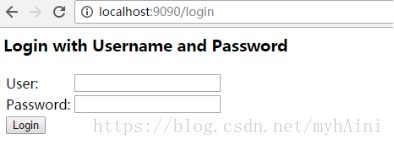Spring Security入门小DEMO
Spring Security是一个能够为基于Spring的企业应用系统提供声明式的安全访问控制解决方案的安全框架。它提供了一组可以在Spring应用上下文中配置的Bean,充分利用了Spring IoC,DI(控制反转Inversion of Control ,DI:Dependency Injection 依赖注入)和AOP(面向切面编程)功能,为应用系统提供声明式的安全访问控制功能,减少了为企业系统安全控制编写大量重复代码的工作.
Spring Security入门小Demo
首先看一下目录结构

(1)创建工程spring-security-demo ,pom.xml内容
<project xmlns="http://maven.apache.org/POM/4.0.0" xmlns:xsi="http://www.w3.org/2001/XMLSchema-instance"
xsi:schemaLocation="http://maven.apache.org/POM/4.0.0 http://maven.apache.org/maven-v4_0_0.xsd">
<modelVersion>4.0.0modelVersion>
<groupId>cn.itcast.demogroupId>
<artifactId>spring-security-demoartifactId>
<packaging>warpackaging>
<version>0.0.1-SNAPSHOTversion>
<properties>
<spring.version>4.2.4.RELEASEspring.version>
properties>
<dependencies>
<dependency>
<groupId>org.springframeworkgroupId>
<artifactId>spring-coreartifactId>
<version>${spring.version}version>
dependency>
<dependency>
<groupId>org.springframeworkgroupId>
<artifactId>spring-webartifactId>
<version>${spring.version}version>
dependency>
<dependency>
<groupId>org.springframeworkgroupId>
<artifactId>spring-webmvcartifactId>
<version>${spring.version}version>
dependency>
<dependency>
<groupId>org.springframeworkgroupId>
<artifactId>spring-context-supportartifactId>
<version>${spring.version}version>
dependency>
<dependency>
<groupId>org.springframeworkgroupId>
<artifactId>spring-testartifactId>
<version>${spring.version}version>
dependency>
<dependency>
<groupId>org.springframeworkgroupId>
<artifactId>spring-jdbcartifactId>
<version>${spring.version}version>
dependency>
<dependency>
<groupId>org.springframework.securitygroupId>
<artifactId>spring-security-webartifactId>
<version>4.1.0.RELEASEversion>
dependency>
<dependency>
<groupId>org.springframework.securitygroupId>
<artifactId>spring-security-configartifactId>
<version>4.1.0.RELEASEversion>
dependency>
<dependency>
<groupId>javax.servletgroupId>
<artifactId>servlet-apiartifactId>
<version>2.5version>
<scope>providedscope>
dependency>
dependencies>
<build>
<plugins>
<plugin>
<groupId>org.apache.maven.pluginsgroupId>
<artifactId>maven-compiler-pluginartifactId>
<version>3.2version>
<configuration>
<source>1.7source>
<target>1.7target>
<encoding>UTF-8encoding>
configuration>
plugin>
<plugin>
<groupId>org.apache.tomcat.mavengroupId>
<artifactId>tomcat7-maven-pluginartifactId>
<configuration>
<port>9090port>
<path>/path>
configuration>
plugin>
plugins>
build>
project>(2)创建web.xml
<web-app xmlns:xsi="http://www.w3.org/2001/XMLSchema-instance"
xmlns="http://java.sun.com/xml/ns/javaee"
xsi:schemaLocation="http://java.sun.com/xml/ns/javaee http://java.sun.com/xml/ns/javaee/web-app_2_5.xsd"
version="2.5">
<context-param>
<param-name>contextConfigLocationparam-name>
<param-value>classpath:spring-security.xmlparam-value>
context-param>
<listener>
<listener-class>
org.springframework.web.context.ContextLoaderListener
listener-class>
listener>
<filter>
<filter-name>springSecurityFilterChainfilter-name> <filter-class>org.springframework.web.filter.DelegatingFilterProxyfilter-class>
filter>
<filter-mapping>
<filter-name>springSecurityFilterChainfilter-name>
<url-pattern>/*url-pattern>
filter-mapping>
web-app>(3)创建index.html 内容略
(4)创建spring 配置文件spring-security.xml
<beans:beans xmlns="http://www.springframework.org/schema/security"
xmlns:beans="http://www.springframework.org/schema/beans" xmlns:xsi="http://www.w3.org/2001/XMLSchema-instance"
xsi:schemaLocation="http://www.springframework.org/schema/beans http://www.springframework.org/schema/beans/spring-beans.xsd
http://www.springframework.org/schema/security http://www.springframework.org/schema/security/spring-security.xsd">
<http use-expressions="false">
<intercept-url pattern="/**" access="ROLE_USER" />
<form-login/>
http>
<authentication-manager>
<authentication-provider>
<user-service>
<user name="admin" password="123456" authorities="ROLE_USER"/>
user-service>
authentication-provider>
authentication-manager>
beans:beans>
配置说明:
intercept-url 表示拦截页面
/* 表示的是该目录下的资源,只包括本级目录不包括下级目录
/** 表示的是该目录以及该目录下所有级别子目录的资源
form-login 为开启表单登陆
use-expressions 为是否使用使用 Spring 表达式语言( SpEL ),默认为true ,如果开启,则拦截的配置应该写成以下形式
<intercept-url pattern="/**" access="hasRole('ROLE_USER')" />用户自定义登录页
实际开发中,我们不可能使用系统生成的登录页,而是使用我们自己的登录页。
(1)构建登陆页:
<html>
<head>
<meta http-equiv="Content-Type" content="text/html; charset=UTF-8">
<title>登陆title>
head>
<body>
<form action='/login' method='POST'>
<table>
<tr>
<td>用户名:td>
<td><input type='text' name='username' value=''>td>
tr>
<tr>
<td>密码:td>
<td><input type='password' name='password' />td>
tr>
<tr>
<td colspan='2'><input name="submit" type="submit"
value="登陆" />td>
tr>
table>
form>
body>
html>(2)构建登陆失败页 login_error.html(内容略)
(3)修改 spring 配置文件spring-security.xml
<http pattern="/login.html" security="none">http>
<http pattern="/login_error.html" security="none">http>
<http use-expressions="false">
<intercept-url pattern="/*" access="ROLE_USER" />
<form-login login-page="/login.html" default-target-url="/index.html" authentication-failure-url="/login_error.html"/>
<csrf disabled="true"/>
http>security=”none” 设置此资源不被拦截.
如果你没有设置登录页security=”none” ,将会出现以下错误

因为登录页会被反复重定向。
login-page:指定登录页面。
authentication-failure-url:指定了身份验证失败时跳转到的页面。
default-target-url:指定了成功进行身份验证和授权后默认呈现给用户的页面。
csrf disabled=”true” 关闭csrf ,如果不加会出现错误

CSRF(Cross-site request forgery)跨站请求伪造,也被称为“One Click Attack”或者Session Riding,通常缩写为CSRF或者XSRF,是一种对网站的恶意利用。